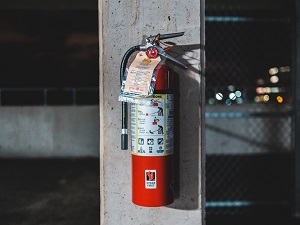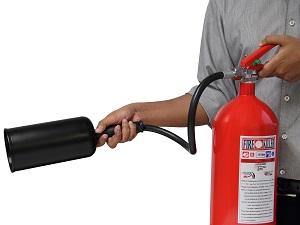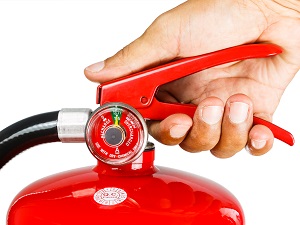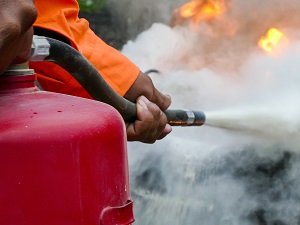Fire extinguishers are valuable tools in any organization’s fire prevention program. Using a fire extinguisher may seem easy, but it is best for every employee to have some basic knowledge of fire safety including an understanding of the different types of fires and fire extinguishers, how to make a decision to attempt to fight a fire or evacuate, and how to use a fire extinguisher in the event of a fire emergency.

In the United States, there are 5 major classifications of fire, known as A, B, C, D and K. Depending on which class of fire ignites will determine how trained personnel act to extinguish the fire. Remember, different types of fire extinguishers are designed to fight different classes of fire.
Fire requires three elements which are fuel, heat and oxygen, known as the fire triangle, and in the right combination the resulting chemical reaction can cause a fire. The key to extinguishing a fire is to remove at least one of the elements from the fire and this is what portable fire extinguishers are designed to accomplish.
Fire extinguishers are classified by the type of fire they are intended to be used on. They can have a classification like A, ABC, BC, D or K that easily explains the type of fire they are designed to fight.
OSHA Standard 1926.150(a)(1) The employer shall be responsible for the development of a fire protection program to be followed throughout all phases of the construction and demolition work, and shall provide for the firefighting equipment.

Portable fire extinguishers are labeled with color-coded letters and/or pictograms that indicate the type of fire they are designed to extinguish. There are 5 classes of fire and portable fire extinguishers will be labeled to show they are suitable to fight one or more of these types.
It is critically important that the right type of extinguisher be used on the specific class of fire to avoid personal injury and damage to property. Using the wrong type of fire extinguisher could be ineffective, result in electrical shock, cause an explosion or even spread the fire.
OSHA Standard 1910.157(g)(1) Where the employer has provided portable fire extinguishers for employee use in the workplace, the employer shall also provide an educational program to familiarize employees with the general principles of fire extinguisher use and the hazards involved with incipient stage fire fighting.
Reminder: Portable fire extinguishers are useful for putting out small fires, but they are not effective against larger fires or fires that are spreading quickly.

Portable fire extinguishers release an extinguishing agent from the nozzle when someone compresses the handle. They work when the extinguishing agent is expelled onto the fire and one or more of these reactions happen:
- the burning fuel is cooled sufficiently to stop the fire
- oxygen sustaining the fire is displaced or removed
- the chemical reaction causing the fire is stopped so the fire cannot continue to burn
When you have made the decision to attempt to put out a fire with a fire extinguisher, remember to take these actions in this order.
- ACTIVATE the fire alarm system and notify emergency services, or delegate someone to do this.
- ASSIST anyone nearby to exit the area, preferably by exiting the building (if indoors), or ensure that the emergency action plan has started that will ensure safe evacuation of all personnel.
- ATTEMPT to extinguish the fire.
Only attempt to use a fire extinguisher to put out a fire if all of these conditions exist.
- the fire is small and contained
- you are safe from toxic smoke
- there is a clear exit path behind you
- no additional hazards put you at risk

All employees should be familiar with the location and types of extinguishers available. Take time to review the operating instructions and warnings found on the fire extinguishers in your work area.
Fire extinguishers can be heavy, so it’s a good idea to practice picking up and holding the extinguishers to understand the weight and feel. This will also provide a good indication if you will feel comfortable using the extinguisher in the event of an unexpected fire.
Only use a portable fire extinguisher to attempt to put out a fire if the fire is contained to a small area.
A useful way to remember the best method for using a fire extinguisher is with the acronym PASS, which stands for Pull, Aim, Squeeze and Sweep.
- Pull the pin in the handle of the fire extinguisher.
- Aim the hose or nozzle at the base of the fire while making sure you are a safe distance away.
- Squeeze the operating lever slowly to expel the fire extinguishing agent onto the fire.
- Sweep the hose or nozzle from side to side, at the base of the fire, until the fire is out. Move forward or around the area where the fire is, if it is safe to do so, as the fire diminishes. Watch the area closely after the fire seems to be out to ensure re-ignition won’t occur.

Before using a fire extinguisher, activate the fire alarm and identify a safe evacuation route. Always keep an escape exit to your back when using a portable fire extinguisher. Do not use a fire extinguisher if your means of evacuation is unclear or compromised. Once the fire extinguisher is empty, evacuate immediately if you were unable to put the fire out.
Always ensure portable fire extinguishers are inspected monthly, maintained in good operating condition, and store in highly visible, easily accessible locations. Report any fire extinguishers that have been used. Even if the extinguisher was used for a short time, it should be reported as used.
If using a carbon dioxide (CO2) fire extinguisher, do not touch the plastic horn as it can become very cold and cause damage to skin.


